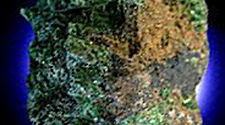
A significant component of the UK baseline inventory is separated uranium. The vast majority of this separated uranium is Depleted, Natural and Low Enriched Uranium (DNLEU). If all of the DNLEU contained in the current baseline inventory were to be disposed of in a Geological Disposal Facility, DNLEU wastes would represent a significant fraction of the disposed volume. In a recent study for the Nuclear Decommissioning Authority Radioactive Waste Management Directorate (NDA RWMD), Quintessa assessed the key controls on the performance of a number of different disposal concept options (combinations of wasteform, waste container and backfill) that might be considered for DNLEU.
The approach taken in this study was to develop an understanding of the safety functions that each of the different barriers might provide and the requirements placed on the disposal system by DNLEU wastes. This allowed a conceptual understanding to be developed of the processes that might occur in the near field. Of particular relevance is the nature and behaviour of possible wasteforms and the controls on uranium solubility. Therefore, canditate wasteform types and controls on uranium solubility limits under different conditions were examined using thermodynamic modelling, experimental data and evidence from natural analogues.
Seven disposal concept options for DNLEU were defined that represent combinations of barriers (and barrier materials) and host rock for which the authors considered it plausible that a post-closure safety case might be successfully made for DNLEU wastes. A series of scoping calculations were then carried out to explore the performance of these disposal concept options in terms of their ability to limit the flux of uranium out of the near field.